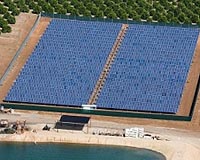 |
Changzhou, China (AFP) Dec 3, 2009 In Trina Solar's brilliant white factory in eastern China, masked workers in lab coats turn silicon wafers into solar power cells capable of harnessing the sun's clean and limitless energy. China is now the world's top producer of the cells -- the tile-like engines of solar panels -- and firms like Trina see next week's climate talks as a potential key moment in the wider adoption of renewable energies like solar. "The Copenhagen talks, from our point of view, are going to be positive," Terry Wang, Trina's chief financial officer, told AFP in an interview. "A global target for emissions cuts would have a positive impact across all 20 countries we sell to." As the world seeks to curb the carbon emissions blamed for global warming, companies such as Trina illustrate how central China will be to that effort. Thanks to a surging Chinese solar cell industry, there may have never been a better time for the world to go solar. Chinese production capacity surged more than fourfold in the past year to 8 gigawatts -- more than the total global 2010 demand of 7.5 gigawatts in solar panels, according to Yuanta Securities. Meanwhile, a collapse in financing for large solar projects in Europe -- linked to the world financial crisis -- has pushed solar cell prices to near historic lows. As a result, the prices for solar modules -- the grid-like panels typically comprising 60 cells -- are half what they were at the beginning of 2008, said Min Li, a Hong Kong-based analyst at Yuanta Securities. Global solar power demand last year roughly equalled 10 medium-sized coal-fired electricity plants, said Rory Macpherson, investor relations director at China's New York Stock Exchange-listed SunTech, the world's largest solar panel maker. "For solar to be effective in decreasing carbon emissions, we really need to increase the scale and adoption many times over," he said. As the world's leading source of carbon emissions, China has launched ambitious plans to increase use of renewable energies like wind but has yet to harness the sun. Yet that is changing. China did not figure in Trina's sales charts last year, but will account for two to three percent of the New York-listed company's sales this year, Wang said, adding he expected China sales to double in 2010. Domestic customers will represent about five percent of SunTech's sales this year, Macpherson said. "In the next three or four years it could be one of the world's largest markets," he said. Beijing kick-started a solar drive this year with its "Golden Sun" stimulus plan to subsidise half the cost of solar power generation and transmission facilities, rising to 70 percent in remote, off-grid areas. The government last week announced the first batch of 294 projects, which are expected to come on line within three years and generate 642 megawatts at a cost of 20 billion yuan (2.9 billion dollars). It did not specify how much it would pay in "Golden Sun" grants, adding it wanted to gradually reduce Chinese producers' reliance on overseas sales and build infrastructure so the national grid can tap solar power. China announced last week it planned to curb 2020 emissions per unit of gross domestic product by 40-45 percent from 2005 levels. It had already set a target of generating 15 percent of its power through renewable sources, including solar power, by 2020. Renewables are expected to account for 10 percent of China's energy by 2010, according to officials. That means it will have to add 1.8 megawatts of solar generation per year from 2011 to 2020, Yuanta's Li said. "Starting from 2011, China's domestic market will be on a par with some of the leading European countries," he said. The sector remains dependent on subsidies, especially European producers. Still, Trina, which boasts the lowest prices in the market, expects strong growth in Italy, France and the United States next year. European producers accuse Chinese producers of selling panels at unsustainably low prices to grab market share. Wang rejects the allegation, saying Trina's gross profit margin in the third quarter of this year rose to 29 percent from 22 percent a year earlier due to falling costs. "Government incentives will not last forever," he said. "We should continue to reduce the price of solar systems so we can be more competitive with traditional power generation. That's healthy for the solar sector." Share This Article With Planet Earth
Related Links All About Solar Energy at SolarDaily.com
 Maryland's Largest Solar Farm
Maryland's Largest Solar FarmSilver Spring MD (SPX) Dec 03, 2009 CPV Renewable Energy (CPV REC) has announced plans for a 10 megawatt (MW) solar farm in southern Maryland to be co-located with the proposed natural gas combined-cycle CPV St. Charles Energy Center. The announcement was made as part of American Community Properties Trust (ACPT) 9,100 acre planned "Model Green City" in Charles County. Named the CPV Piney Reach Solar Farm, the planned ... read more |
|
| The content herein, unless otherwise known to be public domain, are Copyright 1995-2009 - SpaceDaily. AFP and UPI Wire Stories are copyright Agence France-Presse and United Press International. ESA Portal Reports are copyright European Space Agency. All NASA sourced material is public domain. Additional copyrights may apply in whole or part to other bona fide parties. Advertising does not imply endorsement,agreement or approval of any opinions, statements or information provided by SpaceDaily on any Web page published or hosted by SpaceDaily. Privacy Statement |